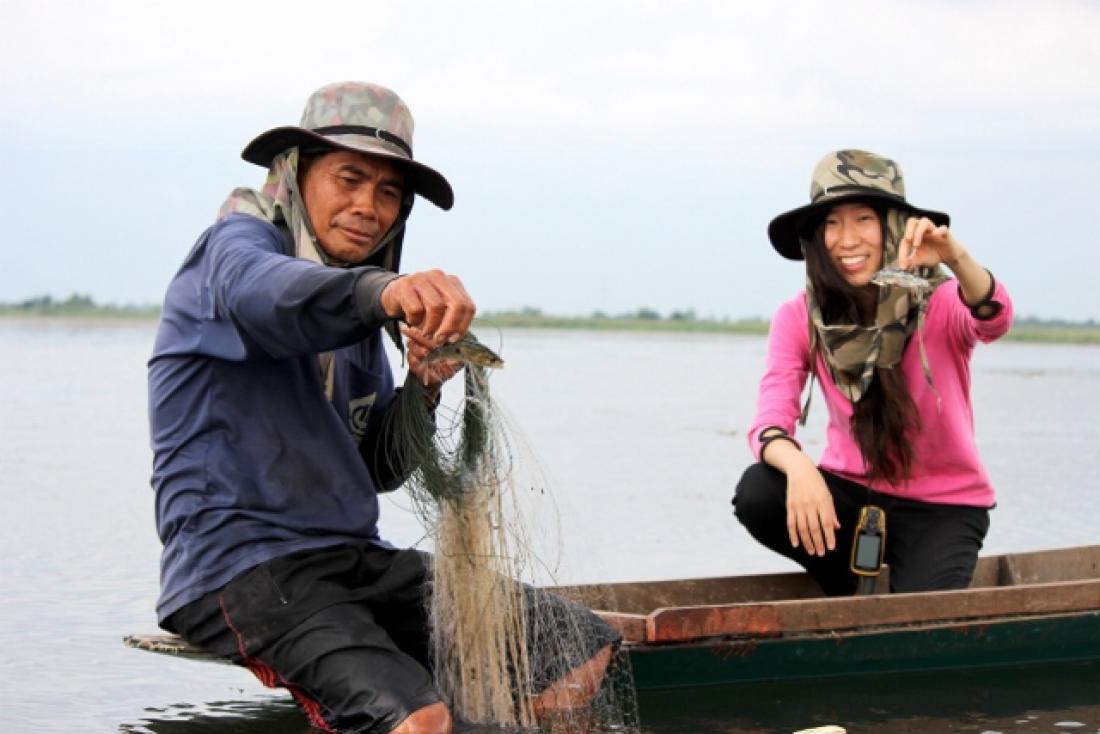Communities monitor local carp (cyprinoid) populations. Eaten raw, these fish are the main culprit behind human infection. Copyright: TROPICAL DISEASE RESEARCH LABORATORY/KHON KAEN UNIVERSITY
Raw fish with spiced salad—koi pla—is a favourite dish in Thailand. But each year, thousands of people are infected with Opisthorchis viverrini, a liver fluke parasite transmitted to humans through raw or undercooked fish. Thailand has the world's highest incidence of cholangiocarcinoma—a fatal form of liver cancer associated with O. viverrini. In some areas, nearly 85% of the population hosts the parasite. Villages in northeast Thailand, where raw fish is popular, have some of the country's highest rates of infection. Those infected may carry the adult parasite for years, with symptoms ranging from indigestion, to malnutrition, organ inflammation, and potentially cancer in prolonged cases.
Standard drug treatment of those infected with liver flukes has, by itself, been ineffective in breaking the cycle of transmission in highly affected communities. The organism infects not only people, but animals such as cats and dogs that also eat raw fish. Many of those who carry the fluke have no symptoms, and continue to contaminate local water sources with egg-contaminated feces, in areas where there is poor sanitation. As a result of these complex factors, liver fluke transmission stubbornly persists in affected communities.
The research: testing a new model of intervention
Since 2008, Thailand's National Health Security Office and Khon Kaen University had been exploring a new model of intervention to address liver fluke infection in the Lawa Lake area of Thailand's Khon Kaen province, where O. viverrini is endemic. In 2011, as part of a multi-country research partnership focusing on parasitic diseases in China and five countries in Southeast Asia, the team received training in ecohealth approaches. These complement infectious disease research with socio-economic, ecological, and systems science perspectives. Researchers were then able to strengthen the "Lawa Model" by looking at how lake ecosystems and local dietary and sanitation practices might be fostering transmission.
Eleven villages with a total population of 5,600 were initially screened, with four villages then selected as test sites for the new ecohealth approach. The Lawa Model combines medical treatment of infected humans and animals, intensive community and school-based health education, and ecosystem monitoring to break the parasite's life cycle and prevent new infections.
As a first step, the Ministry of Public Health used the worm-killing drug Praziquantel to treat infected community members and their animals. Next, village health volunteers were trained on the life cycle and transmission of the liver fluke and how community members can protect themselves. These volunteers—village leaders, local health officials, school teachers—were agents of change. They organized public exhibits to raise awareness through vivid depictions of the parasite and its effects. For example, they used microscopes to show fellow villagers infected liver specimens and the flukes themselves. They used folk songs and videos to explain transmission. Sixteen health volunteers visited 186 households and organized liver fluke campaigns in local schools, educating the community on the risks of eating raw fish and safe defecation practices.
This combination of treatment and community education has been highly effective because of the parasite's complex life cycle. Eggs in the lake water are consumed by local species of freshwater snails— the parasites' first host, in which they hatch and grow for six to eight weeks. They then target local cyprinoid fish species, forming cysts in their muscle tissue. When the fish are eaten, by humans or animals, the parasites lodge in the bile ducts where they mature as adults and begin to lay eggs. When eggs are transmitted back to the lake through fecal contamination, the cycle begins again.
By following proper treatment and sanitation measures, community members have broken this cycle. Because the host fish have a life span of just two to three years, rapid progress has been made.
The results: a dramatic drop in infection
As a result of community efforts, the infection rate among villagers fell by half, between 2011 and 2013. And infection rates in the fish which transmit the parasite declined from 70% to less than 1%.
The Lawa Model has since gained national and international recognition, and is being expanded to other parts of Thailand and neighbouring countries. Thailand's Department of Disease Control and the Ministry of Public Health plan to apply the approach in every province in the northeast, establishing the Lawa Lake area as a training site for integrated liver fluke control in endemic regions. Through peer-review publication and presentations at international conferences, findings are now available to health institutions worldwide.
Results of the Lawa Model
Human infection in test sites has dropped by half.
Infection among host fish species has dropped from 70% to less than 1%.
Thai authorities are adopting the approach across the country's Northeast.
The project, "Innovative Strategies for the Sustainable Control of Asian Schistosomiasis and Other Helminth Zoonoses through Socio-Ecosystem Based Interventions," is one of three multi-country projects supported through the Ecohealth Emerging Infectious Diseases Research Initiative (Eco EID) — a research and capacity-building collaboration in Southeast Asia. Eco EID is funded by Canada's Department of Foreign Affairs, Trade and Development through the Global Health Research Initiative, the Australian Department of Foreign Affairs and Trade, and IDRC. Since 1996, IDRC has supported multidisciplinary research that looks at the interactions between ecosystems, social dynamics, and human health.



